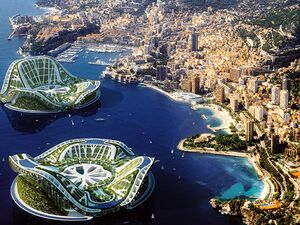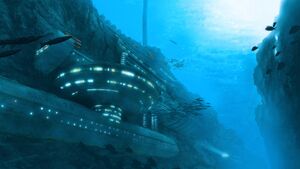Avalon Fleet Yards: Difference between revisions
More actions
CrimsonTacit (talk | contribs) No edit summary |
CrimsonTacit (talk | contribs) No edit summary |
||
| Line 13: | Line 13: | ||
===== Deuterium Refineries ===== | ===== Deuterium Refineries ===== | ||
The planet's deuterium refineries are largely automated. Clusters of these refineries are connected by flexible but tough piping to bunkers on the ocean's floor. It takes many months for the refineries to fill up each bunker, at which point tankers transfer the deuterium to orbital storage facilities. Smaller quantities of deuterium can also placed in cargo shuttles fitted out as tankers from small landing pads at each refinery, and this is often done when ships in orbit need a top-off. | The planet's deuterium refineries are largely automated. Clusters of these refineries are connected by flexible but tough piping to bunkers on the ocean's floor. It takes many months for the refineries to fill up each bunker, at which point tankers transfer the deuterium to orbital storage facilities. Smaller quantities of deuterium can also placed in cargo shuttles fitted out as tankers from small landing pads at each refinery, and this is often done when ships in orbit need a top-off. | ||
===== Research Stations ===== | |||
[[File:AvalonUnderwaterScience.jpg|alt=A Starfleet Marine Biology station built into the side of an underwater cliff to study pelagic life.|thumb|A Starfleet Marine Biology station built into the side of an underwater cliff to study pelagic life.]] | |||
There are multiple research stations on Avalon II, studying the planet's unique ecosphere, mineral deposits, and other areas of interest. The higher density of heavy water means that those on the ocean floor must be specially reinforced. These facilities are run by a mix of Starfleet Science offices and civilian Federation agencies. | |||
=== Brahms Station === | === Brahms Station === | ||
Revision as of 16:11, 27 March 2023
Facilities
Avalon Fleet Yards is a massive installation with orbital and planet-side facilities. The yard's headquarters and the living quarters for many of its staff are located on Avalon II. The primary orbital facility is Brahms Station, a Probert-class spacedock orbiting between Avalon II and its largest moon, which has been mined extensively for dilithium and has nearly been hollowed out to provide additional space for fabrication and assembly facilities. There are dozens of drydocks around the spacedock and the moon. Additional orbital stations provide research and design, storage, and additional accomodations.
Avalon II Facilities
Avalon II is a Class-O pelagic world with 95% of its surface covered in oceans. Highly unusual for a life-supporting planet, the seas of this world are almost entirely composed of heavy water, that is to say water that contains deuterium rather than hydrogen. While toxic to most carbon-based biologies, it is an important source of fuel for anti-matter reactors, and so Avalon II was initially colonized as a refining station. Floating deuterium refineries bob on the waves around one of the planet's only land masses, which also plays host to the fleet yard's shore facilities. There are several floating landing pads as well, which take advantage of the high density of the planet's oceans to support the construction of small starships with minimal anti-gravity needed. Additional research stations are spread around the planet, both on and under the ocean's surface.
Sato City

Named for early explorer Hoshi Sato, Sato City has a permanent population of 20,000, with housing space for up to 20,000 more transient personnel. Small by Federation standards, this town has all of the comforts one would expect from a Federation colony. Most of the fleet yards' long-term staff live here and take shuttles or transporters into orbit. The landmass here is narrow and rocky, snaking and branching in a way that creates deep fjords between its many peninsulas. This means that most of the structures are narrow and tall, including most of the housing—mainly single-family townhouses. There are a few parks created in the larger flatter areas, and in recent decades floating platforms have been placed in the small coves to provide additional space.
Deuterium Refineries
The planet's deuterium refineries are largely automated. Clusters of these refineries are connected by flexible but tough piping to bunkers on the ocean's floor. It takes many months for the refineries to fill up each bunker, at which point tankers transfer the deuterium to orbital storage facilities. Smaller quantities of deuterium can also placed in cargo shuttles fitted out as tankers from small landing pads at each refinery, and this is often done when ships in orbit need a top-off.
Research Stations

There are multiple research stations on Avalon II, studying the planet's unique ecosphere, mineral deposits, and other areas of interest. The higher density of heavy water means that those on the ocean floor must be specially reinforced. These facilities are run by a mix of Starfleet Science offices and civilian Federation agencies.

